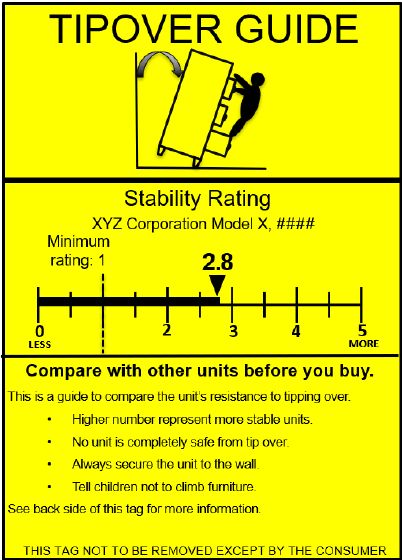The U.S. Consumer Product Safety Commission’s proposed rule for a mandatory furniture stability standard includes a requirement for a new hangtag that would highlight a product’s performance and technical data for consumers.
The proposed rule, released in June, concludes that consumers need “comparative information about the stability of products.” Staff settled on a stability rating, to be displayed on a scale of 0 to 5, that is based on results of the tip-over testing required in the rule. Clothing storage units (CSUs) covered by the rule would need to score at least a “1” to be considered compliant with the stability standard.
Staff also reasoned that the rating system might improve the overall stability of units in the marketplace by “incentivizing manufacturers to produce CSUs with higher levels of stability to better compete in the market.”
However, CPSC admitted in its Notice of Proposed Rulemaking (NPR) for clothing storage furniture that, in all the testing and research conducted in preparation of the NPR, staff found only one unit that could achieve the minimum stability rating of “1”.
In an overview of the proposed rule presented during AHFA’s Sustainability & Regulatory Summit in September, AHFA Vice President of Regulatory Affairs Bill Perdue said he has yet to find a clothing storage unit, regardless of price point, that could reach a rating of “1” without modification. AHFA’s furniture safety task group has tested hundreds of units representing a variety of price points and designs. Without modifications, none reached the minimum “1” rating.
A 189-pound, six-drawer dresser with drawer interlocks tested at the Summit according to the NPR’s proposed protocol scored an 0.89. “Based on what we’ve seen, every clothing storage unit on the market today is going to require modification, and many units will require multiple modifications, just to reach ‘1,’” said Perdue.
Despite the likelihood that degrees of stability for the vast majority of units will be measured in tenths of a point between 1 and perhaps 1.5, the NPR requires a hangtag 5 inches wide by 7 inches tall in bright process yellow to display this rating.
In addition to the 0 to 5 scale and the unit’s stability rating in bold type, the front of the hangtag urges consumers to “Compare with other units before you buy.” The NPR includes size, text and format requirements for the hangtag, as well as a new icon.

The tag must be attached to the CSU “and clearly visible to a person standing in front of the unit.” Ready-to-assemble furniture must display the tag on the “main panel” of the consumer packaging. Lost or damaged hangtags must be replaced. The NPR does not address how the stability rating or other hangtag content will be conveyed for products on an ecommerce sales platform.
Required text on the back of the hangtag attempts to explain the stability rating system to the consumer. Using a rating of 2.8 from the sample hangtag shown above, the explanation would read:
Test data on this unit indicated it withstood 2.8 times the threshold tip over rotational force/moment, per tests required by the Consumer Product Safety Commission (see below).
To reduce tip-over incidents, the U.S. Consumer Product Safety Commission (CPSC) requires that clothing storge units, such as dressers, chests, bureaus, and armoires, resist certain tip-over forces. The test that CPSC requires measures the stability of a clothing storage unit and its resistance to rotational forces, also known as moments. This test is based on threshold rotational forces of 3-year-old child climbing up, hanging on, or pulling on drawers and/or doors of this unit. These actions create rotational forces (moments) that can cause the unit to tip forward and fall over. The stability rating on this tag is the ratio of this unit’s tip-over moment (using CPSC’s test) and the threshold tip-over moment.
Final adoption of the CPSC’s proposed rule would likely take years, but legislation passed in the House and pending in the Senate, known as “STURDY,” could fast-track a mandatory rule, which would likely borrow heavily from the NPR.